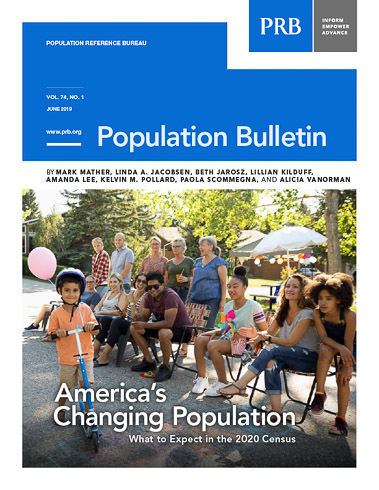
Date
June 22, 2019
Authors
Mark Mather
Associate Vice President, U.S. Programs
Linda A. Jacobsen
Senior Fellow
Beth Jarosz
Senior Fellow, McCourt School of Public Policy at Georgetown University
Lillian Kilduff
Former Research Analyst

Amanda Lee
Former Research Associate
Kelvin Pollard
Former Senior Demographer
Paola Scommegna
Contributing Senior Writer
Alicia VanOrman
Program Director
Population Reference Bureau’s exclusive preview of the upcoming decennial census reveals population shifts with major implications for the nation’s political, social, and economic future.
WASHINGTON, D.C.—Population Reference Bureau (PRB) today released its preview of results from the upcoming 2020 U.S. Census, providing a look at key population and housing trends that will shape the United States in 2020 and beyond.
“The data show a rapidly changing U.S. population, growing more slowly but also shifting in many important ways,” said Mark Mather, associate vice president of U.S. Programs at PRB and lead author of PRB’s latest Population Bulletin, “America’s Changing Population: What to Expect in the 2020 Census.” Mather noted, “The 2020 Census data are critical because they will allow policymakers, businesses, and others to see how America’s communities are changing and help them adapt to the challenges ahead.”
Among the key findings:
- The U.S. population is increasing and could reach a third of a billion people by 2020, but the population is on track to grow at the slowest rate since the 1930s, with wide-ranging impacts on the labor supply and the demand for goods and services—including new homes—over the coming years.
- Fewer households are being established, due in part to the growing share of young adults who still live with their parents. Population growth is on track to outpace household growth this decade for the first time since the 1930s. The slowdown in household growth is likely to impact the housing market and could reduce the demand for home-related services and durable goods, such as major appliances.
- As the U.S. population continues to shift to the South and West, states in those regions will likely gain congressional seats at the expense of states in the Northeast and Midwest, changing the political landscape. Texas gained four seats after the 2010 Census and is expected to gain two or three more after the 2020 count.
- More than half of U.S. counties have experienced net population loss since 2010, with more than 550 counties losing at least 5 percent of their residents, which could result in fewer federal dollars to support local infrastructure and public programs.
- The post-2010 demographic situation is especially bleak in Puerto Rico, which has lost more than half a million residents, or 14 percent of its 2010 population. Florida, with an estimated 21.3 million residents, has surpassed New York as the nation’s third-largest state behind California and Texas. Utah, Texas, Florida, Colorado, and North Dakota were the fastest-growing states overall.
- The percentage of U.S. residents ages 65 and older is increasing at the fastest pace in U.S. history, with significant implications for public spending on programs for older adults. The increasing costs of providing for an older population may reduce public spending for other groups, including young families with children.
- Children are at the forefront of racial/ethnic change in the United States, creating a diversity gap among generations. Only half of the population under age 18 are projected to be non-Hispanic white by 2020, compared with three-fourths (76 percent) of those ages 65 and older.
- Growing racial/ethnic diversity in the United States is no longer being driven by immigration, but by patterns of births and deaths among the U.S. resident population. The population identifying with two or more races is projected to be the fastest-growing racial/ethnic group between 2010 and 2020, increasing by 36 percent.
- A growing divide in homeownership rates between whites and blacks is increasing the wealth gap between racial and ethnic groups. Since 2010, homeownership rates for most racial/ethnic groups held steady or increased, but the rate for blacks continued to drop, especially among young adults.
Contact: Leslie Aun laun@prb.org
About Population Reference Bureau (PRB)
PRB informs people around the world about population, health, and the environment, and empowers them to use that information to advance the well-being of current and future generations.

 ">
">











